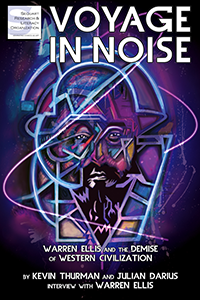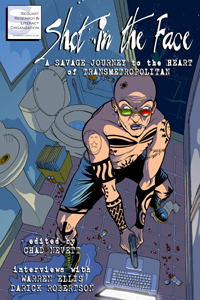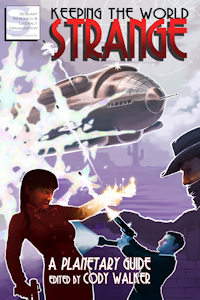We’ve previously looked at Warren Ellis’s overall realistic worldview and how this is reflected in the revisionism of his much-celebrated 1999-2003 period. We now turn to his work at Marvel from 2004-2010.
Warren Ellis at Ultimate Marvel, 2004-2006
 Ellis returned to mainstream super-hero work for Marvel’s highly successful Ultimate Universe in 2004. He wrote Ultimate Fantastic Four for a year (#7-18, Aug 2004 – June 2005) and authored the “Ultimate Galactus Trilogy” (Ultimate Nightmare #1-5, Oct 2004 – Feb 2005; Ultimate Secret #1-4, May-Dec 2005; and Ultimate Extinction #1-5, Mar-July 2006).
Ellis returned to mainstream super-hero work for Marvel’s highly successful Ultimate Universe in 2004. He wrote Ultimate Fantastic Four for a year (#7-18, Aug 2004 – June 2005) and authored the “Ultimate Galactus Trilogy” (Ultimate Nightmare #1-5, Oct 2004 – Feb 2005; Ultimate Secret #1-4, May-Dec 2005; and Ultimate Extinction #1-5, Mar-July 2006).
While not as aggressively revisionist as Ruins, Stormwatch, or DV8, these new works nonetheless represented a return to those tendencies. The Ultimate Universe was a good home for Ellis, because it was initially conceived as a more realistic setting, more closely representing readers’ own world (by, for example, not knowing of the existence of extraterrestrial life). The opportunity the universe offered to revise Marvel characters allowed their often silly origins (many of which dated to the 1960s) to be updated according to increased standards of logic and realism. In essence, the Ultimate Universe was conceived as a loosely revisionist universe. The nature of Ellis’s Ultimate work may have simply represented a writer adjusting himself to the demands of a particular job, and Ellis has given no indication that these were labors of love. But they were fairly revisionist nonetheless.
On Ultimate Fantastic Four, Ellis took over following the title’s first storyline, which revised the heroes’ origins, along pseudo-scientific lines – but which only partially introduced the team’s arch-nemesis and concluded without the public becoming aware of the heroes’ existence. Ellis’s task was essentially to complete the team’s origin story. He turned the first storyline into a trilogy of interconnected storylines, collectively telling the team’s origin. Ellis’s two stories introduced newly pseudo-scientific versions of Victor Von Doom and the Negative Zone, which in its retooled version was tied into the team’s origin, helping to make the team’s overall origin story cohere. Ellis’s final storyline ended with the team’s public revelation to the world, completing his more realistic take on the team. Along the way, references to how the team’s powers required better exploration could have been at home in Ruins, albeit where they would have had a very different tone.
While the quasi-realistic tone Ellis brought to the series reflected the storyline before him and the Ultimate Universe more generally, he could have gone another direction. Mark Millar, the title’s next major writer, reversed the title’s tone completely, embracing reconstructionism. His first issue announces this intention immediately; it begins with the team already back in time (using technology not previously seen), stopping terrorists who are threatening to derail evolution. It’s a brilliant idea, but it’s pure reconstructionist spectacle, eschewing the realism – and careful, slow, logical construction – that had previously characterized the title. It was also very successful, further indicating readers’ super-hero preferences at the time.
Ellis’s Ultimate Galactus trilogy offered a remarkably realistic revision of the original Galactus story. Instead of a silly extraterrestrial giant, Galactus, the “Devourer of Worlds,” was retooled as a technological swarm with a collective consciousness. He wasn’t even named “Galactus” – why would an alien call himself that? – but the more realistic “Gah Lak Tus.” Along the way, Ellis offered an alternative explanation for the famous Tunguska explosion – and even for the Fermi paradox (the reason we don’t observe highly advanced civilizations in the Milky Way, despite the math suggesting we should, is that they tend to be destroyed by Galactus). Also, Earth’s victory is achieved more realistically, through quasi-realistic science involving harnessing the power of parallel universes that doesn’t defeat the incredibly powerful foe so much as scare it off through manipulating its cost-benefit analysis.
Ellis’s Ultimate work wasn’t as revisionist or realistic as his Ruins, Stormwatch, or DV8. It did preserve some of the widescale action Ellis had brought to The Authority. But it represented a shift back towards Ellis’s realistic, revisionist tendencies.[1]
Nextwave, 2006-2007
 Ellis rose to top-tier status within American comics in 1999 with Planetary and The Authority, which were such strong and different works that they felt like a reinvention of the super-hero genre. But by the middle of the following decade, Ellis’s career hadn’t produced anything of equivalent creative power and influence. Ellis promoted Nextwave (illustrated by Stuart Immonen) as the answer, claiming it was designed to be an equally new take on super-heroes.
Ellis rose to top-tier status within American comics in 1999 with Planetary and The Authority, which were such strong and different works that they felt like a reinvention of the super-hero genre. But by the middle of the following decade, Ellis’s career hadn’t produced anything of equivalent creative power and influence. Ellis promoted Nextwave (illustrated by Stuart Immonen) as the answer, claiming it was designed to be an equally new take on super-heroes.
If Ellis had stripped Stormwatch of its intelligence to create The Authority, reducing the genre to “widescreen” fights with huge stakes, he now sought to reduce this formula further. At the 2006 Heroes Con, he described Nextwave as The Authority minus “plots, logic, character[,] and santiy.” He elaborated, saying, “It’s people posing in the street for no good reason. It is people getting kicked, and then exploding.” The result, said Ellis, was “an absolute distillation of the super-hero genre.”
This says a lot about how Ellis sees that genre, or at least the preferences of its fans. His own description of Nextwave is characterized by its stupidity, posing, and constant action. If readers preferred mindless spectacle, Nextwave was designed to give it to them – to out-Authority The Authority, if you will.
But the most successful super-hero comics of the preceding decades took themselves rather seriously, even when their content was at its most ridiculous. Nextwave, however, felt irreverent, even satirical. Indeed, it frequently included flashbacks in which Marvel characters act violently with little motivation, apparently for comedic effect. The series certainly was different: it was frenetic, over-the-top, and eschewed continuity. But it wasn’t what mainstream super-heroes wanted, and the series was cancelled after one year (#1-12, Mar 2006 – Feb 2007).[2]
Perhaps Ellis couldn’t dumb down (or “distill”) the super-hero any more, without inserting satire into the vacuum. Perhaps this satire reflected the writer’s own feelings about the kind of mindless spectacle super-hero readers seemed to want. Nextwave certainly had very little to do with reality, Ellis’s forte.
Other Marvel Super-Hero Work, 2005-2010
 Of course, Ellis wrote other things during this period. After beginning his Ultimate Universe work, he wrote the “Extremis” arc for Iron Man (Vol. 4 #1-6, Jan 2005 – May 2006, illustrated by Adi Granov), which offered a loosely revisionist take on the character, not unlike the reinventions of Marvel characters for the Ultimate Universe. The story revised Iron Man’s origins, emphasized the political dimensions of his role as an arms dealer, and effectively gave him super-powers for the first time, using Ellis’s penchant for realistic-sounding pseudo-science – in this case, the possibilities of nanotechnology, combined with organic elements. However, like Ellis’s wildly successful Planetary and The Authority (and to a lesser extent the Ultimate Universe generally), many fans seemed as interested in the story’s art as the story itself – something that tends to be true especially of reconstructionist works and might have helped audiences accept the revisionist elements Ellis contributed. In fact, the story is now included on many lists of the best Iron Man stories.
Of course, Ellis wrote other things during this period. After beginning his Ultimate Universe work, he wrote the “Extremis” arc for Iron Man (Vol. 4 #1-6, Jan 2005 – May 2006, illustrated by Adi Granov), which offered a loosely revisionist take on the character, not unlike the reinventions of Marvel characters for the Ultimate Universe. The story revised Iron Man’s origins, emphasized the political dimensions of his role as an arms dealer, and effectively gave him super-powers for the first time, using Ellis’s penchant for realistic-sounding pseudo-science – in this case, the possibilities of nanotechnology, combined with organic elements. However, like Ellis’s wildly successful Planetary and The Authority (and to a lesser extent the Ultimate Universe generally), many fans seemed as interested in the story’s art as the story itself – something that tends to be true especially of reconstructionist works and might have helped audiences accept the revisionist elements Ellis contributed. In fact, the story is now included on many lists of the best Iron Man stories.
 Arguably more characteristic of Ellis’s revisionist tendencies is newuniversal (#1, Feb 2007), a reinvention of Marvel’s New Universe (featuring several titles, published from 1986-1989). In its original incarnation, the New Universe had been conceived as a revisionist super-hero universe. Particular attention was paid to realism, and for this reason, extraterrestrials, magic, supernatural beings, and unrealistic super-technology were originally excluded. The world within the comics was supposed to be more realistic, recognizable, and relatable to readers. In addition, characters would be allowed to change and to have lasting effects on the world around them, and the various titles were said to take place in real time, avoiding the sliding timescale common to corporate super-heroes. Even the term “super-heroes” was avoided, in favor of the term “paranormals.” Essentially, the New Universe was intended to be a revisionist Marvel Universe, existing alongside the old one, which couldn’t embrace these kinds of changes to the nearly same degree.
Arguably more characteristic of Ellis’s revisionist tendencies is newuniversal (#1, Feb 2007), a reinvention of Marvel’s New Universe (featuring several titles, published from 1986-1989). In its original incarnation, the New Universe had been conceived as a revisionist super-hero universe. Particular attention was paid to realism, and for this reason, extraterrestrials, magic, supernatural beings, and unrealistic super-technology were originally excluded. The world within the comics was supposed to be more realistic, recognizable, and relatable to readers. In addition, characters would be allowed to change and to have lasting effects on the world around them, and the various titles were said to take place in real time, avoiding the sliding timescale common to corporate super-heroes. Even the term “super-heroes” was avoided, in favor of the term “paranormals.” Essentially, the New Universe was intended to be a revisionist Marvel Universe, existing alongside the old one, which couldn’t embrace these kinds of changes to the nearly same degree.
While a noble experiment, the New Universe failed to sufficiently attract readers, and several titles were cancelled, while others changed their premise dramatically. The overall concept had also failed to deliver on the idea of lasting change. To rectify this, Marvel offered The Pitt (one-shot, Dec 1987), in which a super-hero accident destroys Pittsburgh and its suburbs, leaving only a crater behind and killing approximately half a million people. In the wake of this event, for which no cause is apparent, the United States suspends some civil rights and shifts into a much more militaristic stance (foreshadowing its real-world response to 9/11), while international tensions rise. This led the U.S. to draft paranormals, a highly realistic and revisionist idea (that would later be used, in the Marvel universe proper, in the Civil War crossover mini-series). This eventually culminated in war with the Soviet Union, as depicted in The War (#1-4, Oct 1989 – Mar 1990), the final publication of the New Universe.
The failure of the New Universe, despite its ambitions, loomed large and was frequently cited to suggest any new universes, shared by multiple titles, would fail. This was especially true when Marvel launched its Ultimate Universe, which debuted with some of the same revisionist intentions (e.g. making the world depicted more recognizable, without awareness of extraterrestrial life). The success of the Ultimate Universe, combined with nostalgia, might have suggested that it was time for the New Universe to return. That Warren Ellis was the one to write it, however, makes perfect sense, given Ellis’s inclinations towards realism and revisionist super-heroes – concerns the New Universe had been designed to embody. The two were a natural fit.
Unlike the original New Universe, Ellis’s newuniversal was (like the revisionist masterpiece Watchmen) a story about an alternate history that deviated from our own world before the story began. Richard Nixon won the 1960 presidential election, beating John F. Kennedy. The Soviet Union collapsed much earlier, and China took the lead in spaceflight; by the time the series opens, China has bases on the moon. China also has a certain cultural cache: its comics occupy a place in the American landscape that Japanese manga have in our own world. As the series opens, Hillary Clinton is the U.S. president. While all of this diverges from “reality,” it’s classic alternative history in the model of Watchmen and other realistic works (including Ellis’s own Ministry of Space).
The series even featured minimalist covers, an updated version of classic 1980s revisionist works (like Watchmen and Dark Knight Returns).
Unfortunately, artist Salvador Larroca left the series with issue #6 (July 2007), and it was consequently put on hiatus. A year later, Ellis followed with the two-issue Newuniversal: Shockfront (#1-2, July-Aug 2008), penciled by Steve Kurth. This was, in turn, followed by two flashback one-shots written by other writers.[3] Ellis’s plans for the series were reported lost in a 2009 computer crash, and he’s said that he doubts the series will return. While newuniversal is a powerful demonstration of Ellis’s tendency towards revisionism, it’s also an example of how some of Ellis’s works have gone uncompleted.[4]
Ellis also had a high-profile, 12-issue run on Thunderbolts (#110-121, Mar 2007 – Aug 2008), illustrated by Mike Deodato, Jr. The run followed up on Marvel’s 2006-2007 Civil War crossover mini-series (written by Mark Millar and penciled by Steve McNiven), which was itself a combination of very strong revisionist realism and the kind of entertaining, art-friendly storytelling popularized by reconstructionism. The mini-series had the U.S. government force super-heroes to reveal their identities to the U.S. government, which drafted them – and super-villains – into service. Like the Ultimate Universe or the New Universe, this set-up seemed tailor-made for Ellis’s realistic, political concerns.
Thus, Ellis introduced a new team of Thunderbolts, former villains now working for the U.S. government and hunting down unlicensed super-heroes. Ellis said he would approach the series “from a political agenda.” But despite these revisionist themes, the series ran late, and Ellis departed after two six-issue storylines.
 Ellis landed an even more high-profile gig when Marvel chose him to follow Joss Whedon as writer of Astonishing X-Men Vol. 3, then the premiere X-Men title. As he often has with mainstream super-hero work, Ellis infused the series with sci-fi themes, including pseudo-science about parallel universes. He also created a dump, where many of the various spaceships that had visited the Marvel Universe over the years were left – along with their technology.
Ellis landed an even more high-profile gig when Marvel chose him to follow Joss Whedon as writer of Astonishing X-Men Vol. 3, then the premiere X-Men title. As he often has with mainstream super-hero work, Ellis infused the series with sci-fi themes, including pseudo-science about parallel universes. He also created a dump, where many of the various spaceships that had visited the Marvel Universe over the years were left – along with their technology.
Despite such gestures towards realism, Ellis’s run was plagued by delays. (Ironically, Whedon’s work had also run late, and Marvel promised that Ellis would fix this. Yet it wasn’t until Ellis’s departure that the title became a true monthly.)
Ellis’s run was further damaged by artistic inconsistency. Each of Ellis’s storylines had a different artist, and while each was a major talent, the result added to the sense of disconnection between the plots of Ellis’s storylines, preventing his run from gelling.
Instead of amassing a major run to follow Whedon’s work, Ellis only completed three storylines: “Ghost Box” (#25-30, Sept 2008 – Aug 2009), illustrated by Simone Bianchi; “Exogenetic” (#31-35, Dec 2009 – Oct 2020), penciled by Phil Jimenez and inked by Andy Lanning; and “Xenogenesis” (published as Astonishing X-Men: Xenogenesis #1-5, July 2010 – Apr 2011), illustrated Kaare Andrews. “Ghost Box” was accompanied by a two-issue mini-series (Astonishing X-Men: Ghost Boxes #1-2, Dec 2008 – Jan 2009) telling loosely-related short stories illustrated by various artists. Despite the tremendous talent involved, the run is widely viewed as abortive, and it fails to successfully build the themes or continuing plot threads that usually define a run and hold it together as a whole.
As a mainstream super-hero writer, despite writing many excellent and interesting works, Ellis remains most known for his Planetary and The Authority. Even those were produced for WildStorm and only happened to be published by DC Comics because DC purchased WildStorm not long before the two series debuted. Ellis’s most creatively successful work tends either to not be in the super-hero genre (e.g. Transmetropolitan) or to have been produced outside of American comics’ two main companies – or both.
Next: Warren Ellis’s super-hero work for Avatar.
[1] Ellis would later return to the Ultimate Universe for a couple of mini-series, Ultimate Human (#1-4, Mar-June 2008) and Ultimate Armor Wars (#1-4, Nov 2009 – Apr 2010). Both are lesser works – and less realistic than his earlier Ultimate Universe work.
[2] Ellis said (on his website in October 2006) that he planned, after 12 issues, to hand Nextwave over to another writer, much as he had done with The Authority (further linking those two projects, at least in terms of Ellis’s thinking and intentions). But with sales sluggish, and artist Stuart Immonen tasked to take over the far better-selling Ultimate Spider-Man, Nextwave was simply cancelled instead.
[3] Specifically, Newuniversal: 1959 #1 (Sept 2008) and Newuniversal: Conqueror #1 (Oct 2008).
[4] Also uncompleted is Desolation Jones, published by WildStorm, which ended two issues into its second storyline (with #8, Feb 2007). Other series (e.g. Ellis’s Astonishing X-Men), while not necessarily unfinished, have petered out, and even more (including Planetary) faced significant publication delays.





































































